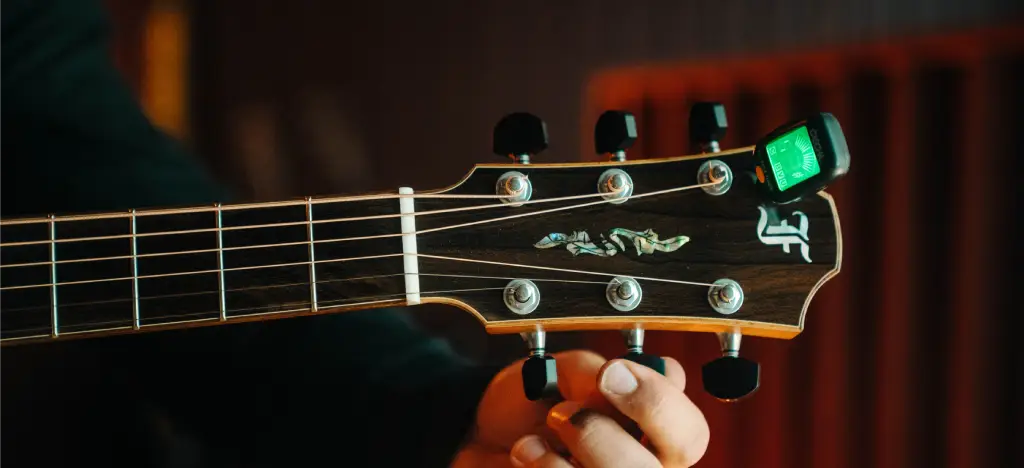Before you strum along to your first song or dive into your favourite riffs, you have to take a minute to make sure your guitar is in tune. Tuning might seem a bit intimidating at first, especially for beginners, but it's actually a quick and easy skill to master!
Whether you’re a beginner guitarist or looking for a bit of guidance, we'll walk you through everything you need to know about guitar tuning, from the basics (like what those tuning peg things do!) to using a tuner and even some cool alternative tunings. Plus, we’ve included a bonus video tutorial by guitarist and creator Dre DiMura, along with a free online tuner to help you get started.
- How to tell if your guitar is out of tune
- Understanding your guitar tuning mechanism
- What is standard guitar tuning?
- Guitar tuning methods
- How to use an electronic tuner to tune your guitar
- Free guitar tuning video guide with Dre DiMura
- How to tune a guitar by ear?
- What are alternative guitar tunings?
- Why does my guitar keep going out of tune?
- How often should you tune a guitar?
- Guitar tuning tips and tricks
- Want to improve your guitar playing?
How to tell if your guitar is out of tune
An out-of-tune guitar is generally obvious when you play a chord, but if you're just getting started, it might not be so clear. Here are a couple of tips:
Listen for Disharmony
Strum a few chords and listen carefully. If the chords sound off, with notes clashing instead of blending harmoniously, your guitar is likely out of tune. This is especially noticeable with common guitar chords like G, C, and D.
Check Single Notes
Play each string individually. Even if the chords sound somewhat acceptable, single notes can more clearly reveal tuning issues. If any string sounds flat or sharp compared to its expected pitch, it needs adjustment.
Now, let's look at how to adjust the strings using the tuning pegs on the headstock.
Understanding your guitar tuning mechanism
 Tuning pegs, also known as machine heads, tuning keys or tuners, allow you to adjust the tension of the strings and thereby their pitch. Familiarizing yourself with how they work will make the tuning process much smoother.
Tuning pegs, also known as machine heads, tuning keys or tuners, allow you to adjust the tension of the strings and thereby their pitch. Familiarizing yourself with how they work will make the tuning process much smoother.
There are two main types of guitar tuning pegs: open-gear and sealed-gear. Open-gear tuners have exposed gears, often seen on vintage guitars and acoustics, while sealed-gear tuners have enclosed gears for protection, commonly found on modern electric guitars.
Each tuning peg corresponds to one string and is used to adjust its pitch. Turning the peg tightens or loosens the string:
Tightening the String: Turn the peg clockwise to increase the tension, raising the pitch.
Loosening the String: Turn the peg counterclockwise to decrease the tension, lowering the pitch.
Take a moment to identify each peg and understand how they control the tension of your strings.
What is standard guitar tuning?
This tuning was developed as the most practical and comfortable way to play both chords and melodies. Whether playing acoustic or electric, beginners often start with standard tuning to familiarize themselves with the instrument and to make use of readily available learning resources.
From the lowest (thickest) string to the highest (thinnest) string:
E — A — D — G — B — E
One way to remember the order is to use a mnemonic:
Eat All Day Get Big Easy
Every Amateur Does Get Better Eventually
Eddie Ate Dynamite Good Bye Eddie
Guitar tuning methods
When it comes to tuning your guitar, there are two main methods to choose from. Whether you're a beginner or more experienced player, these methods offer different approaches to achieving the perfect pitch:
1. Using an Electronic Tuner
This method is highly recommended for beginners due to its simplicity and accuracy. You can use clip-on tuners that attach to the guitar headstock, pedal tuners designed for electric or semi-acoustic guitars, or even smartphone apps and online tuners.
2. Tuning by Ear
For more advanced players with a keen ear for music, tuning by ear involves using a reference tone to adjust each string. While it requires practice, it offers a deeper understanding of pitch and can be done using various methods, which we'll explore later in this guide.
Now, let's take a look at how to tune your guitar using a digital tuner.
How to use an electronic tuner to tune your guitar
 Especially for beginners, an electronic tuner is your best friend for getting your guitar in tune quickly and easily. Clip-on tuners are particularly convenient. Here's how to use one:
Especially for beginners, an electronic tuner is your best friend for getting your guitar in tune quickly and easily. Clip-on tuners are particularly convenient. Here's how to use one:
Attach the tuner: Clip it onto your guitar's headstock (or plug it in or open the app).
Pluck a string: The tuner will display the note you're playing.
Tune using the indicator: If the tuning indicator is to the left of centre, the string is flat. If it's to the right of centre, the string is sharp. Adjust the tuning peg until the indicator centres.
If you don't have a clip-on tuner handy, you can use our free online tuner!
Free guitar tuning video guide with Dre DiMura
For a quick and simple video guide to guitar tuning, check out viral sensation Dre DiMura explaining how in this exclusive video from his course.
If this has inspired you to pick up that guitar, try out his course (and all our other courses) for free with our 7-day free trial!
► ARTMASTER TIP: To help you on your way, take a look at our collection of free essential guitar tools, where you’ll find the guitar tuner, a chord chart generator and metronome. And be sure to check out our guides on how to read a chord chart and how to practice with a metronome.
How to tune a guitar by ear?
The other method, tuning by ear, involves using a reference tone to tune the rest of the strings. This method is often favoured by experienced players or those with a keen ear for music. It requires practice and patience, but it will help improve your sense of pitch.

Step 1 — Tune the low E string first
Begin by tuning your low E string using another instrument or an online reference tone as your reference point.
Step 2 — Use the 5th fret for reference
Hold down the fifth fret on the low E string. This will produce the note A, which should match the pitch of the next open string.
Step 3 — Repeat for each string
Continue this process for each remaining string BUT note that for the fourth (G) and fifth (B) strings, the B string's pitch is found on the fourth fret of the G string, not the fifth!
What are alternative guitar tunings?
The great thing about guitar is that there are several alternative tunings to choose from. These can open up new sonic landscapes, simplify complex chord shapes, and inspire fresh creativity in your guitar playing. Try them out!
Remember, the open string pitches below go from low to high.
Standard tuning (E-A-D-G-B-E)
Open G tuning (D-G-D-G-B-D) — favoured in blues and folk
DADGAD tuning (D-A-D-G-A-D) — Celtic/folk with intricate harmonies
Open D tuning (D-A-D-F#-A-D) — resonant for expressive slide blues
Drop D tuning (D-A-D-G-B-E) — popular in rock and metal for its deep, resonant tone
Why does my guitar keep going out of tune?
If you find your guitar goes out of tune a lot, you're not alone. There are many possible reasons:
Climate: Temperature and humidity swings can affect your guitar's tuning. Aim for a stable environment and consider a humidifier in dry climates.
New Strings: Fresh strings stretch as you play, so they need frequent retuning until they settle.
Worn Strings: Old strings lose their elasticity and go out of tune more easily. Replace them regularly.
Tuning Pegs: Loose pegs can cause strings to go flat. Gently tighten them for better grip.
Bridge & Nut: Issues with these components can also affect tuning. For serious problems, consider a professional setup.
► ARTMASTER TIP: Unfortunately, we’re all too often faced with a broken string. Find out how to change a guitar string, including expert tips and a free video tutorial.
How often should you tune a guitar?
The secret to a well-tuned guitar? Regular tuning! It's a good habit to tune your guitar every time you play, and even to check the tuning mid-session. This way, you can catch any strings that have drifted out of tune due to vigorous strumming or extended play.
Guitar tuning tips and tricks
Invest in Quality Gear: Use a high-quality tuner for accuracy, and choose premium strings for better tone and durability.
Tune Up to Pitch: Always tune your strings by tightening them up to the correct pitch to ensure stability.
Allow Strings to Settle: After tuning, give the strings a moment to settle into place.
Gently Stretch Strings: Lightly stretch the strings by pulling them away from the fretboard. This helps them stay in tune longer.
Fine-Tune Intonation: Check and adjust the intonation across the fretboard to ensure each note is perfectly in tune.
Double-Check Your Tuning: Recheck your tuning after playing for a while to maintain accuracy.
Handle Your Guitar with Care: Treat your guitar gently to avoid knocking it out of tune.
Tune Regularly: Make tuning a habit before each practice or performance to ensure your guitar sounds its best.
Want to improve your guitar playing?
Now you’ve tuned your strings, learn guitar online with one of our popular online guitar courses from beginner acoustic or electric guitar to colourful chord techniques and guitar soloing.
Try Our FREE 7-Day Trial!


